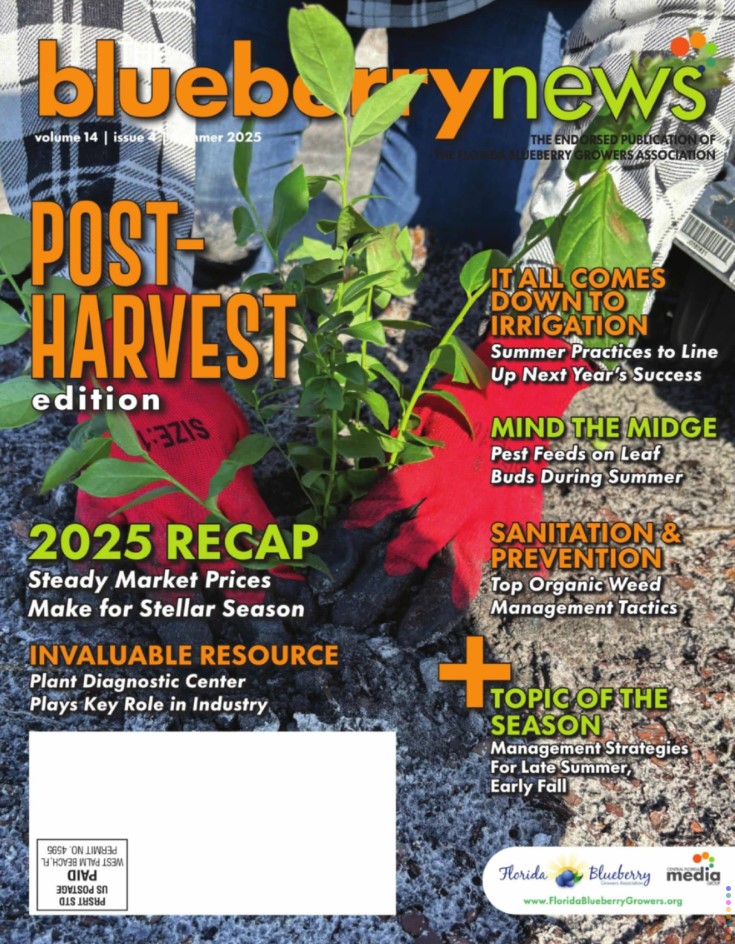
Effective methods for Florida’s soil type and blueberry root systems
PROPER IRRIGATION is essential for maximizing fruit yield and minimizing drought stress of southern highbush blueberry plants grown in Florida. Drought stress can reduce berry yield and quality, as well as increase susceptibility to various diseases including blueberry stem blight. On the other hand, excessive soil moisture can weaken root systems and promote soil–borne diseases, such as Phytothphora root rot. Most Florida blueberry soils are composed largely of sand. Blueberries are often grown in these sandy soils after amending the soil with pine bark, or in pine bark beds atop well-drained sandy soils. If soil drainage is marginal, raised beds are used to keep the root systems well above the water table.
Neither sands nor sands amended with pine bark have high water holding capacities compared to many agricultural soils with larger percentages of silt and clay. For example, fine sand will hold only 0.04 to 0.09 inches of water per inch of soil verses a loam or silt loam, which will hold 0.17 to 0.23 inches of water per inch of soil (several times greater). Moreover, southern highbush blueberry plants have shallow root systems, with the majority of roots in the upper few inches to one foot of the soil profile, making blueberry plants very susceptible to water stress during periodic droughts.
Figure 1 (below) shows the shallow root system of an excavated southern highbush blueberry plant that was grown in a pine bark bed. The finer roots that are responsible for water and nutrient uptake were located primarily in the pine bark layer on top of the native soil. Figure 2 (below) shows a trench profile next to a blueberry plant growing in a pine bark bed. Again, the majority of roots are in the pine bark layer with only a small percentage of roots extending into the non-amended soil below.


Florida blueberry growers often rely on a combination of drip and overhead irrigation. Overhead irrigation is commonly used for freeze protection and may also be used during young plant establishment, and as a supplement to drip irrigation during drought conditions. A well-managed drip irrigation system can be efficient and is well-suited for fertigation and chemigation. However, water applied with drip irrigation in sand and/or pine bark tends to move downward rapidly with very little horizontal movement. Figure 3 (below) shows wetting patterns (blue dye) from drip emitters run for 13 minutes in pine bark. The narrow pattern does not conform well to the shallow, laterally spreading shape of the blueberry root system, as illustrated in Figure 1. Figure 4 (below) shows water distribution from drip emitters after 13 minutes in bark-incorporated soil. Again, there is rapid vertical movement with perhaps slightly more lateral spread, but still not conforming to the shape of a typical blueberry root system. Growers often use two drip lines per row to increase lateral coverage of the root zone. The wetting pattern from a properly designed micro-sprinkler system would conform better to the shape and distribution of a blueberry root system, but this technology has not been widely adopted by blueberry growers in Florida.


A blueberry plant’s water requirement will depend on plant canopy size, growth stage, and environmental conditions. Other things being equal, a larger plant will require more water than a smaller plant because of greater transpiration due to greater leaf surface area. However, applying too much water during one irrigation event will result in water (and nutrient) movement below the root zone where it is unavailable for plant uptake. Because the typical blueberry soil has low water holding capacity, and blueberry plants have shallow root systems, short, frequent drip irrigation cycles are more efficient than longer irrigation cycles that would move water and nutrients below the root zone. For this reason, many growers “pulse irrigate” larger plants using multiple irrigations of short duration in an attempt to provide adequate irrigation while minimizing loss to deep percolation.
Blueberry plant water use increases rapidly as plants emerge from dormancy, flower, and develop their spring crop. For example, average water use of mature ‘Emerald’ plants (> five feet tall) in north-central Florida increased from approximately 0.67 gal/plant/ day in February to about 1.4 gal/plant/day in March (post-bloom and early fruit development). By May, average water use had increased to 1.9 gal/plant/day. The period from March through May is often accompanied by low rainfall, making this period of fruit development and increasing plant water demand critical for proper irrigation management. Plant water use was high (approximately 2 gal/plant/day) during mid- to late-summer as canopies redeveloped following summer pruning but declined significantly in October (approximately 1.25 gal/plant/day), and continued to decline with the shortening days, cooler temperatures, and as plants approached dormancy. Actual daily water use differed somewhat from these monthly averages, depending on changing weather and crop conditions during a given month. Furthermore, plant canopy size will have a direct effect on plant water use. Plant water use, as described here, should not be directly equated to irrigation amounts since rainfall will influence irrigation needs.
As we approach the 2017 growing season, growers should be mindful of blueberry plants’ increasing water requirements as they emerge from dormancy, set fruit, and develop leaf canopies. Plant water requirements will be largely dependent on plant canopy size. Plant rooting depth and distribution, and the soil water holding properties in the root zone, are necessary information to develop an efficient and effective irrigation schedule. For shallow-rooted blueberry plants in soils with low water holding capacities, the general rule should be light, frequent irrigations designed to meet the plant water requirements that are not met by rainfall.
CREDITS
pump house photo by PEZZIMENTI
story and figures by JEFF WILLIAMSON and GARY ENGLAND
Jeff Williamson is a professor and Extension specialist, Horticultural Sciences Department, UF/IFAS. Gary England is a regional specialized Extension agent and director of the Hastings Agricultural Extension Center, UF/IFAS.





